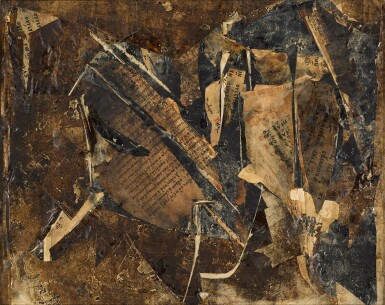
Property from the Collection of Anne and William Frej
Teresa Rudowicz
Composition, 1956
Lot Closed
November 9, 02:15 PM GMT
Estimate
4,000 - 6,000 GBP
Lot Details
Description
Property from the Collection of Anne and William Frej
Teresa Rudowicz
Polish
1928 - 1994
Composition, 1956
signed and dated TERESA RUDOWICZ / 1956/31 on the reverse
collage on canvas
Unframed: 43 by 53cm., 17 by 20¾in.
Framed: 55 by 65.8cm., 21¾ by 26in.
‘Every work of art is an incarnation: an investment of matter with spirit. The term ‘assemblage’ has been singled out with this duality in mind, to denote not only a specific technical procedure and form used in the literary and musical as well as the plastic arts, but also a complex of attitudes and ideas. Just as the introduction of oil painting in 15th century Flanders and Italy paralleled a new desire to reproduce the appearance of the visible world, collage and related modes of construction manifest a predisposition that is characteristically modern’
William C Seitz
The present work, executed in 1956, is an early captivating example of Rudowicz’s collage works. An ambiguous, multi-layered surface is made up of ‘ready-made objects’ such as scraps of old writing torn from letters, books or ledgers. As described in the catalogue from the Modern Art Museum exhibition in 1961, the works are reminiscent - with the old soaked paper and glue - of the crumbling and peeling walls of Krakow’s medieval buildings. Her collages, also known as assemblages, became a unique and strong visual language and one that she continued to explore throughout her career.
Rudowicz studied in the years 1948 to 1950 at the State School of Fine Arts in Gdańsk (later the Academy of Fine Arts). She obtained a diploma in 1954 at the studio of Czesław Rzepiński. Rudowicz was a Member of the Group of Krakow (reactivated after World War II) and a number of her earlier works were photomontages and paintings executed in watercolour inspired by surrealism. She also created abstract paintings and then in the 1980s she worked on expressive paintings often with religious subjects. At this time, she was associated with the independent culture movement and towards the end of her life she returned to creating collages.
Rudowicz was included in the exhibition Fifteen Polish Painters at the Museum of Modern Art in 1961. It was the first comprehensive exhibition in the US focused on the new art movement in Poland with works dating from the late 1950s to 1961. This important exhibition was originally planned as an expression of the thawing in relations between the US and the Government of the Polish Peoples' Republic and to highlight the efflorescence of art in Poland after World War II. However, the Polish government pulled its support due to the abstract and non-objective nature of the paintings, so works were instead primarily sourced from galleries and private collections in the US. Later in 1961, she was also included in the exhibition Art of the Assemblage also at the Museum of Modern Art.
You May Also Like










